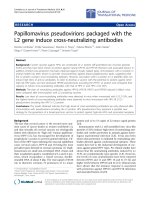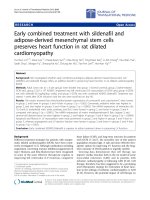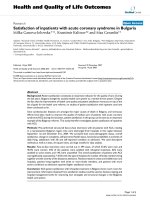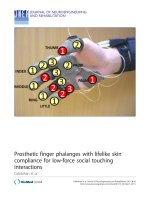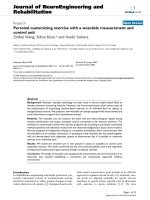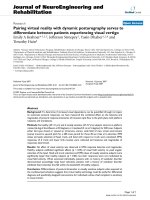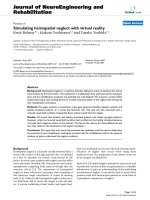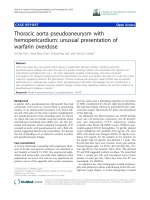Báo cáo hóa học: " Wavelet Video Denoising with Regularized Multiresolution Motion Estimation" pptx
Bạn đang xem bản rút gọn của tài liệu. Xem và tải ngay bản đầy đủ của tài liệu tại đây (2.38 MB, 11 trang )
Hindawi Publishing Corporation
EURASIP Journal on Applied Signal Processing
Volume 2006, Article ID 72705, Pages 1–11
DOI 10.1155/ASP/2006/72705
Wavelet Video Denoising with Regularized
Multiresolution Motion Estimation
Fu Jin, Paul Fieguth, and Lowell Winger
Department of Syste ms Design Engineering, Faculty of Engineering, University of Waterloo, Waterloo, ON, Canada N2L 3G1
Received 1 September 2004; Revised 23 June 2005; Accepted 30 June 2005
This paper develops a new approach to video denoising, in which motion estimation/compensation, temporal filtering, and spatial
smoothing are all undertaken in the wavelet domain. The key to making this possible is the use of a shift-invariant, overcomplete
wavelet transform, which allows motion between image frames to be manifested as an equivalent motion of coefficients in the
wavelet domain. Our focus is on minimizing spatial blurring, restricting to temporal filtering when motion estimates are reliable,
and spatially shrinking only insignificant coefficients when the motion is unreliable. Tests on standard video sequences show that
our results yield comparable PSNR to the state of the art in the literature, but with considerably improved preservation of fine
spatial details.
Copyright © 2006 Fu Jin et al . This is an open access article distributed under the Creative Commons Attribution License, which
permits unrestricted use, distribution, and reproduction in any medium, provided the original work is properly cited.
1. INTRODUCTION
With the maturity of digital video capturing devices and
broadband transmission networks, many video applica-
tions have been emerging, such as teleconferencing, re-
mote surveillance, multimedia services, and digital televi-
sion. However, the video signal is almost always corrupted
by noise from the capturing devices or during transmission
due to random thermal or other electronic noises. Usually,
noise reduction can considerably improve visual quality and
facilitate the subsequent processing tasks, such as video com-
pression.
There are many existing video denoising approaches in
the spatial domain [1–4], which can roughly be divided into
two or three classes.
Temporal-only
An approach utilizes only the temporal correlations [1],
neglecting spatial information. Since video signals are
strongly correlated along motion trajectories, motion esti-
mation/compensation is normally employed. In those cases
where motion estimation is not accurate, motion detection
[1, 5] may be used to avoid blurring. These techniques can
preserve spatial details well, but the resulting images usually
still contain removable noise since spatial correlations are ne-
glected.
Spatio-temporal
More sophisticated methods exploit both spatial and tempo-
ral correlations, such as simple adaptive weighted local aver-
aging [6], 3D order-statistic algorithms [2], 3D Kalman fil-
tering [3], and 3D Markov models [7]. However, due to the
high structural complexity of natural image sequences, accu-
rate modeling remains an open research problem.
Spatial-only, a third alternative, would apply 2D spatial
denoising to each video frame, taking advantage of the vast
image denoising literature. Work in this direction shows lim-
ited success, however, because 2D denoising blurs spatial de-
tails, and because a spatial-only approach ignores the strong
temporal correlations present in video.
Recently, many wavelet-based image denoising ap-
proaches have been proposed with impressive results [4,
8–10]. However, it is interesting to note that although
there have been many papers addressing wavelet-based im-
age denoising, comparatively few have addressed wavelet-
based video denoising. Roosmalen et al. [11] proposed
video denoising by thresholding the coefficients of a spe-
cific 3D wavelet representation and Selesnick and Li [12]
employed an efficient 3D orientation-selective wavelet trans-
form, 3D complex wavelet transforms, which avoids the time-
consuming motion estimation process. The main drawbacks
of the 3D wavelet transforms include a long-time latency and
the inability to adapt to fast motions.
2 EURASIP Journal on Applied Signal Processing
In most video processing applications, a long latency is
unacceptable, so recursive approaches are widely employed.
Pizurica et al. [5] proposed sequential 2D spatial and 1D
temporal denoisings, in which they first do sophisticated
wavelet-based image denoising for each fr a me and then re-
cursive temporal averaging. However, 2D spatial filtering
tends to introduce artifacts and to remove weak details along
with the noise. Due to difficulties in estimating motion in
noise, only simple motion detection was used in [5]toutilize
temporal correlation between frames.
Given the strong decorrelative properties of the wavelet
transform and its effectiveness in image denoising, we are
highly motivated to consider spatial-temporal video fil-
tering, but entirely in the wavelet domain. That is, to
maintain low latency, we employ a frame-by-frame recur-
sive temporal filter but, unlike [5], perform all filtering in
the wavelet domain. However for wavelet-domain motion
estimation/compensation to be possible, predictable image
motion must correspond to a predictable motion of the
corresponding wavelet coefficients. The key, therefore, to
wavelet-based video denoising is an efficient, shift-invariant,
overcomplete wavelet transform. The benefits of such an ap-
proach are clear.
(1) The recursive, frame-by-frame approach implies low
latency.
(2) The wavelet decorrelative property allows very simple,
scalar temporal filtering.
(3) Where motion estimates are unreliable, wavelet
shrinkage can provide powerful denoising.
The remaining challenges, the design of a robust approach to
wavelet motion estimation and the selection of a particular
spatial-temporal denoising scheme, are studied in this paper.
2. WAVELET-BASED VIDEO DENOISING
In standard wavelet-based image denoising [4], a 2D wavelet
transform is used because it leads to a sparse, efficient repre-
sentation of images, thus it would seem natur al to select 3D
wavelets for video denoising [11, 12]. As already discussed,
however, there are compelling reasons to choose a 2D spatial
wavelet transform with recursive temporal filtering.
(1) There is a clear asymmetry between space and time,
in terms of correlation and resolution. A recursive ap-
proach is naturally suited to this asymmetry, whereas
a3Dwavelettransformisnot.
(2) Recursive filtering can significantly reduce time delay
and memory requirements.
(3) Motion information can be efficiently exploited with
recursive filtering.
(4) For autoregressive models, the optimal estimator can
be achieved recursively.
2.1. Problem formulation
Given video measurements y, corr upted by i.i.d. Gaussian
noise v, with spatial indices i, j and temporal index k,
y(i, j, k)
= x(i, j, k)+v(i, j, k),
i, j
= 1, 2, , N, k = 1, 2, , M,
(1)
our goal is to estimate the tr ue image sequence x.Definex(k),
y(k), and v(k) to be the column-stacked video fr ames at time
k, then (1)becomes
y(k)
= x(k)+v(k), k = 1, 2, , M. (2)
We propose to denoise in the wavelet domain. Let H be a 2D
wavelet transform operator, then (2)istransformedas
y
H
(k) = x
H
(k)+v
H
(k), (3)
where y
H
(k) = Hy(k), x
H
(k) = Hx(k), and v
H
(k) = Hv(k)
denote the respective vectors in the transformed domain.
Sinceweseekarecursivetemporalfilter,weassertanau-
toregressive form for the signal model
x(k +1)
= A(k)x(k)+B(k)w(k +1) (4)
for some white, stochastic driving process w(k), thus
x
H
(k +1)= A
H
(k)x
H
(k)+B
H
(k)w
H
(k +1). (5)
The inference of A
H
and B
H
, in general a complicated
system-identification problem, is simplified for video by as-
suming that each frame is related equal to its predecessor,
subject to some motion field
d(i, j, k)
=
d
x
(i, j, k), d
y
(i, j, k)
T
. (6)
Given a shift-invariant, undecimated wavelet transform H,
the wavelet coefficients are subject to the same motion as the
image itself, thus the dynamic model (5) simplifies as
x
l
H
(i, j, k +1)= x
l
H
i + d
x
(i, j, k), j + d
y
(i, j, k), k
+0· w
l
H
(i, j, k +1)
(7)
at wavelet level l. It should be noted that (7) approximates
motion as locally translatory and is not able to handle zoom-
ing and occlusions. In our proposed approach, we assess the
validity of (7)forallwaveletcoefficients; when (7)isfound
to be invalid, we make no assumption regarding the temporal
relationship in the dynamic model (5):
x
H
(k +1)= 0 ·x
H
(k)+B
H
(k)w
H
(k +1). (8)
That is, we have a purely spatial problem, to which standard
shrinkage methods can be applied.
2.2. An example: recursive image filtering in
the spatial and wavelet domains
As a quick proof of principle, we can denoise 2D images using
a recursive 1D wavelet procedure, analogous to denoising 3D
video using 2D wavelets. We do not propose this as a superior
approach to image denoising, rather as a simple test of recur-
sive wavelet-based denoising, to motivate related approaches
in the case of video denoising. We use an autoregressive im-
age model and apply a 1D wavelet transform to each column,
Fu Jin et al. 3
Table 1: Percentage increase δ
MSE
in estimation error relative to the optimal estimator, based on filtering each coefficient independently. In
the wavelet case, the independence assumption introduces only slight error when the input PSNR is relatively large (e.g., 10 dB).
SNR(dB) 10 0 −10
δ
MSE
(spatial) 99.1% 209.6% 91.6%
δ
MSE
(overcomplete wavelet [13]) 9.1% 24.1% 36.7%
δ
MSE
(orthogonal Daubechies length-4 wavelet ) 8.2% 21.1% 32.3%
Noisy image
sequence
Overcomplete
2D wavelet
transform
Significance
map
ME/MC
Adaptive
2D wavelet
shrinkage
Motion
detection
Adaptive
Kalman
filtering
Inverse
2D wavelet
transform
Denoised
sequence
Figure 1: Video denoising system.
followed by recursive filtering column by column. We assess
the estimator perfor mance in the sense of relative increase of
MSE:
δ
MSE
=
MSE −MSE
optimal
MSE
optimal
,(9)
where MSE
optimal
is the MSE of the optimal Kalman filter. For
the purpose of this example, we use a common image model
x( i, j)
= ρ
v
x( i −1, j)+ρ
h
x( i, j −1) −ρ
v
ρ
h
x( i − 1, j − 1)
+ w(i, j), ρ
h
= ρ
v
= 0.95,
(10)
which is a causal Markov random field (MRF) model and can
be converted to a vector autoregressive model [14].
The optimal recursive filtering requires the joint pro-
cessing of entire image columns, for image denoising, or of
entire images, for video denoising. As this would be com-
pletely impractical in the video case, for reasons of compu-
tational complexity we recursively filter the coefficients inde-
pendently, an assertion which is known to be false, especially
for overcomplete (undecimated) wavelet transforms. How-
ever, as shown in Table 1, scalar processing in the wavelet do-
main leads to only very moderate increases in MSE relative to
the optimum, even for the strongly correlated coefficients of
the overcomplete wavelet transform, whereas this is not at all
the case in the spatial domain. We conclude, therefore, that
it is reasonable in practice to process the wavelet coefficients
independently, with much better performance than such an
approach in the spatial domain. It should be noted that the
wavelet-based scalar processor is comparable to the optimal
filter when SNR > 10 dB, a condition satisfied in many prac-
tical applications.
3. THE DENOISING SYSTEM
The success of 1D wavelet denoising of images motivates the
extension to the 2D wavelet denoising of v i deo. The block di-
agram of the proposed video denoising system is illustrated
in Figure 1, where the presence of separate temporal and spa-
tial smoothing actions is clear. There are four crucial as-
pects: (1) the choice of 2D wavelet transform, (2) wavelet-
domain motion estimation, (3) adaptive spatial smoothing,
and (4) recursive temporal filtering. These steps are detailed
below.
2D wavelet transform
A huge number of wavelet transforms have been devel-
oped: orthogonal/nonorthogonal, real-valued/complex-val-
ued, decimated/redundant. However, for video denoising, we
desire a wavelet with low complexity, directionality selectiv-
ity, and, crucially, shift-invariance. The shift-invariance, nec-
essary for motion estimation in the wavelet domain, elim-
inates all orthogonal or critically decimated wavelets from
consideration, so the use of an overcomplete transform is
critical.
The 2D dual-tree complex wavelet proposed by Kings-
bury, [12] satisfies these requirements very well, unfortu-
nately it is less convenient for motion estimation since the
motion information is related to the coefficient phase, which
is a nonlinear function of translation. Alternatively, sp ecial-
ly designed 2D wavelet transforms (e.g., curvelet, contourlet)
are sensitive to feature directions, but are computationally
complex for computation. In this paper, we choose to use
an overcomplete wavelet representation proposed by Mal-
lat and Zhong [13], which, although it does not have very
good directional selectivity, has been used for natural image
4 EURASIP Journal on Applied Signal Processing
denoising with impressive results [9, 15]. However, unlike
[9, 15], the wavelet transform employed in this paper has two
(instead of three) orientations per scale.
Multiresolution motion estimation
Motion estimation is required to relate two successive video
frames to allow temporal smoothing. A wide variety of meth-
ods have been studied, however, we will focus on block
matching [1, 6], which is simpler to compute and less sen-
sitive to noise in comparison with other approaches, such as
optical flow and pixel-recursive methods.
Although regular block matching has w idely been studied
and used in video processing, multiresolution block matching
(MRBM) is a much more recent development, but one which
appears very naturally in our context of multi-level wavelets.
Multiresolution block matching was proposed by Zhang
et al. [16, 17] for wavelet-based video coding, where the basic
idea is to start block matching at the coarsest level, using this
estimate as a prediction for the next finer scale. Oddly, a crit-
ically decimated wavelet was used [17], which implies that
the interframe relationship between the wavelet coefficients
varies from scale to scale. A much more sensible choice of
wavelet, used in this paper, is the overcomplete transform,
which is shift-invariant, leading to consistent motion as a
function of scale except in the vicinity of motion boundaries.
Clearly, this high interscale relationship of motion should be
exploited to improve accuracy. We evaluated two traditional
multi resolution motion estimation (MRME) methods and
following these ideas, we developed two new approaches.
(1) The standard MRME scheme [16].
(2) Block matching separately on each level, combined by
median filtering [17].
(3) Joint block matching simultaneously at all levels:
let
l
(i, j, k, d(i, j, k)) denote the displaced frame dif-
ference (DFD) of level l. Then the total DFD over all
levels is defined as
i, j, k, d(i, j, k)
=
J
l=1
l
i, j, k, d(i, j, k)
(11)
and the displacement field d(i, j, k)
= [d
x
(i, j, l),
d
y
(i, j, k)] is found by minimizing (i, j, k, d(i, j, k)).
(4) Block matching with smoothness constraint: the above
schemes do not assert any spatial smoothness or corre-
lation in the motion vectors, which we expect in real-
world sequences. This is of considerable importance
when the additive noise levels are large, leading to ir-
regular estimated motion vectors. Therefore, we in-
troduce an additional smoothness constraint and per-
form BM by solving the optimization problem
arg min
d
i, j
i, j, k, d(i, j, k)
+ γ ·
(p,q)∈N
b
(i, j,k)
d
x
(i, j, k) − d
x
(i + p, j + q, k)
+
d
y
(i, j, k) − d
y
(i + p, j + q, k)
,
(12)
where N
b
(i, j, k) is the neighbor hood set of the ele-
ment (i, j, k)andγ controls the tradeoff between frame
difference and smoothness.
For simplicity, we assume a first-order neighborhood
for N
b
(i, j, k), often used in MRF models for image
processing [9, 15]. It is difficult to derive the optimal
(in the mean-squared error sense) value of γ because
of the high complexity of motion in natural video se-
quences. However, we find experimentally that PSNR
is not sensitive to γ when 0.004 <γ<0.02, as shown
in Figure 2, so we have chosen γ
= 0.01. Also, to keep
the algorithm complexity low, we use the iterated con-
ditional mode (ICM) method of Besag [18]tosolve
the optimization problem in (12). Although ICM can-
not guarantee a global minimum, we find its results
(Section 4) are satisfactory in the sense of both PSNR
and subjective evaluation.
Experimentally, we have found approach 4 to be the most
robust to noise and yield reasonable motion estimates. An
experimental comparison of all four methods follows in
Section 4.
Spatial smoothing
To e ffectively take advantage of spatial correlations while pre-
serving spatial details, adaptive 2D wavelet shrinkage is ap-
plied when the motion estimates are unreliable. As has been
done by others [19, 20], we classify the 2D wavelet coeffi-
cients into significant and insignificant ones, where the sig-
nificant coefficients are left untouched to avoid spatial blur-
ring.
1
Motivated by the clustering and persistence proper-
ties of wavelet transforms, we define significant coefficients
as those which have large local ac tivity:
A
l
(i, j) =
(i, j)∈Ξ
l
y
l
H
(i, j)
·
(i, j)∈Ξ
l+1
y
l+1
H
(i, j)
, (13)
1
To minimize MSE, both significant and insignificant wavelet coefficients
should be shrunk, as in [19, 20] for image denoising. However, for nat-
ural images, shrinking significant coefficients often generates denoising
artifacts, which we hope to avoid. Thus we choose to denoise significant
coefficients only in the temporal domain when motion estimation is ro-
bust.
Fu Jin et al. 5
0.020.0180.0160.0140.0120.010.0080.0060.0040.0020
γ
31.6
31.7
31.8
31.9
32
32.1
32.2
32.3
32.4
PSNR (dB)
Figure 2: Averaged PSNR versus γ curve. PSNR is not sensitive to γ when 0.004 <γ<0.02.
(a) (b) (c)
(d) (e) (f)
Figure 3: Significance maps for a three-level wavelet transform used by the adaptive wavelet shrinkage filter to preserve spatial details. These
significance maps are estimated from a noisy image version: (a) level 1 (horizontal); (b) level 2 (horizontal); (c) level 3 (horizontal); (d) level
1 (vertical); (e) level 2 (vertical); (f) level 3 (vertical).
where Ξ
l
is the neighborhood structure of level l.Incontrast
to [19, 20], in (13) we used the local energy of the parent,
instead of just using the parent itself, to minimize the poten-
tial negative effects of the phase shifts of wavelet filters. The
wavelet significance is found by comparing the activ ity with
a level-dependant threshold T
l
:
S
l
(i, j) =
⎧
⎨
⎩
1ifA
l
(i, j) >T
l
,
0ifA
l
(i, j) ≤ T
l
.
(14)
The thresholds are level-adaptive, set to identify as signifi-
cant 5% of the coefficients on the two finest scales and 10%
on coarser scales. Figure 3 shows the significance maps for
the wavelet coefficients in the first three levels of the image
sequence Salesman, clearly identifying the high-activity (de-
tail) areas, not to be blurred in the 2D wavelet shrinkage.
Given appropriately chosen thresholds T
l
, we model the
insignificant wavelet coefficients, dominated by noise, as in-
dependent zero-mean Gaussian [8, 19]with spatially var y-
ing variances. Motivated by Table 1, processing the wavelet
6 EURASIP Journal on Applied Signal Processing
coefficients independently leads to relatively slight increases
in MSE, in which case the appropriate shrinkage is the
linear-Bayes-Wiener
x
l
H
(i, j) =
σ
l
x
H
(i, j)
2
σ
l
x
H
(i, j)
2
+
σ
l
v
H
2
· y
l
H
(i, j), (15)
where the measurement noise variance (σ
l
v
H
)
2
is given, or
may be robustly estimated [21]. All that remains is the infer-
ence of the process variance (σ
l
x
H
)
2
, which we find as a spatial
sample variance over a 7
× 7 local window of insignificant
coefficients:
σ
l
x
H
(i, j)
2
= max
⎛
⎝
0,
p,q∈S
l
0
y
l
H
2
(i + p, j + q)
p,q∈S
l
0
1
−
σ
l
v
H
2
⎞
⎠
,
(16)
where S
l
0
={(p, q):S
l
(p, q) = 0}.
Wavelet-based recursive filtering
As was illustrated in Section 2, filtering the wavelet coef-
ficients independently, a particularly simple and computa-
tionally efficient approach, gives good results in the sense of
MSE. For video processing, we further develop this idea and
perform temporal Kalman filtering in the wavelet domain,
achieving simple scalar filtering close to optimal Kalman fil-
tering.
Because motion estimation is an ill-posed problem, there
often exist serious estimation errors, for example around
motion boundaries, in which case the temporal dynamic
model (7) is invalid. To adapt to motion estimation errors,
we perform hypothesis testing on (7) to establish validity
based on the observations y
H
. Specifically, when the motion
information is unambiguous,
y
l
H
(i, j, k) − y
l
H
i + d
x
(i, j), j + d
y
(i, j), k − 1
<βσ
l
v
H
,
(17)
only temporal Kalman filtering is used, whereas when the
motion estimates are poor,
y
l
H
(i, j, k) − y
l
H
i + d
x
(i, j), j + d
y
(i, j), k − 1
≥
βσ
l
v
H
,
(18)
we perform only 2D wavelet shrinkage (15) on the insignifi-
cant wavelet coefficients, leaving significant coefficients un-
touched. The threshold β
= 2
√
2issettopreservetemporal
matches for most (
∼ 95%) correctly matched pixels.
The resulting Kalman filter is particularly simple because
of the deterministic form of (7); that is, the standard Kalman
filter [14] reduces to a dynamic temporal averaging filter.
4. EXPERIMENTAL RESULTS
The proposed denoising approach has been tested using the
standard image sequences Miss America, Salesman,andParis,
using a three-level wavelet decomposition. First, Figure 4
compares our regularized (12) and nonregularized (11 )
MRBM approaches with standard MRBM [16] and stan-
dard MRBM with median filtering [17]. Since the true mo-
tion field is unknown, we evaluate the perfor mance of noisy
motion estimation by comparing with the motion field esti-
mated from noise-free images (Figure 4(b)), and by compar-
ing the corresponding denoising results. The unregularized
approaches do not exploit any smoothness or prior knowl-
edge, and therefore perform poorly in the presence of noise
(Figures 4(c), 4(d), 4(e)). In comparison, our proposed ap-
proach gives far superior results (Figure 4(f)). Although our
MRBM approach introduces one new parameter γ,experi-
mentally we found PSNR to be weakly dependent on γ,as
illustrated in Figure 2, and in all of the following tests, we fix
γ
= 0.01.
Next, we compare our proposed denoising approach with
three recently published methods: two wavelet-based video
denoising schemes [5, 12] and one non-wavelet nonlinear
approach [22]. Selesnick and Li [12] generalized the ideas
of many well-developed 2D wavelet-based image denoising
methods and used a complex-valued 3D wavelet transform
for video denoising. Pizurica et al. [5] combined a tempo-
ral recursive filter with sophisticated wavelet-domain im-
age denoising, but without motion estimation. Zlokolica and
Philips [22] used multiple-class averaging to suppress noise,
which performs better than the traditional nonlinear meth-
ods, such as the α-trimmed mean filter [23] and the rational
filter [24]. Table 2 compares the PSNRs averaged from frames
10 to 30 of the sequence Salesman for different noise levels.
Our approach yields higher PSNRs than those in [12, 22],
and is comparable to Pizurica’s results which use a sophisti-
cated image denoising scheme in the wavelet domain. How-
ever, the similar PSNRs between the results of our proposed
method and that of Pizurica et al. [5] obscure the significant
differences, as made very clear in Figures 5 and 6.Inpartic-
ular, we perform less spatial smoothing, shrinking only in-
significant coefficients, but rely more heavily upon temporal
averaging. Thus, our results have very little spatial blurring,
preserving subtle textures and fine details, such as the desk-
top and bookshelf in Figure 5 and the plant in Figure 6.
Table 3 compares the overcomplete and orthogonal
Daubechies-4 wavelet transforms for video denoising. For
the orthogonal Daubechies-4 wavelet transform, we perform
motion estimation and recursive filtering for each scale sep-
arately. We see that the overcomplete wavelet outperforms
the Daubechies wavelet by more than 1dB in PSNR. As dis-
cussed in the introduction, this advantage of the overcom-
plete wavelet is expected, stemming from its shift-invariance,
whereas the orthogonal Daubechies wavelets are highly shift-
sensitive.
5. CONCLUSIONS
We have proposed a new approach to video denois-
ing, combining the power of the spatial wavelet trans-
form and temporal filtering. Most significantly, motion
estimation/compensation, temporal filtering, and spatial
smoothing are all undertaken in the wavelet domain. We
Fu Jin et al. 7
(a)
454035302520151050
0
5
10
15
20
25
30
35
40
(b)
454035302520151050
0
5
10
15
20
25
30
35
40
(c)
454035302520151050
0
5
10
15
20
25
30
35
40
(d)
454035302520151050
0
5
10
15
20
25
30
35
40
(e)
454035302520151050
0
5
10
15
20
25
30
35
40
(f)
Figure 4: A comparison of four methods of motion estimation applied to the Paris sequence (a) with added noise. The three methods of (c)
standard MRBM [16], (d) standard MRBM with median filtering [17], and (e) our unregularized approach (proposed approach 3) do not
exploit any smoothness or prior knowledge of the motion and perform poorly in the presence of noise. In contrast, our proposed approach
(f), smoothness-constrained MRBM with γ
3
= 0.01), compares very closely with the noise-free estimates in (b).
Table 2: Comparison of PSNR (dB) of the proposed method and several other video denoising approaches for the Salesman sequence.
PSNR (original) 28.224.622.1
PSNR (proposed method) 33.931.630.5
PSNR (3D complex DWT [12]) 32.130.529.3
PSNR (Pizurica et al. [5]) 33.731.730.5
PSNR (Zlokolica and Philips [22]) 32.530.829.7
8 EURASIP Journal on Applied Signal Processing
(a) (b)
(c) (d)
(e) (f)
Figure 5: Comparison of (c) denoising of our proposed approach and (d) denoising by Pizurica’s approach [5](σ
v
H
= 15). (a) Represents
the original image and (b) the noisy image. Our approach can better preserve spatial details, such as textures on the desktop as made clear
in the difference images in (e) that represents absolute difference between (a) and (c), and in (f) that represents absolute difference between
(a) and (d).
also avoid spatial blurring by restricting to temporal filtering
when motion estimates are reliable, and spatially shrinking
only insignificant coefficients when the motion is unreliable.
Tests on standard video sequences show that our results yield
comparable PSNR to the state-of-the-art methods in the
literature, but with considerably improved preservation of
fine spatial details. Future improvements may include more
sophisticated approaches to spatial filtering, such as that in
[5], and more flexible temporal models to better represent
image dynamics.
Fu Jin et al. 9
(a) (b)
(c) (d)
(e) (f)
Figure 6: Denoising results for Salesman. Note in particular the textures of the plants, well preserved in our results in (c) that represents
denoising by the proposed approach, but obviously blurred in (d) that represents denoising by Pizurica’s approach [5]. (a) Original image,
(b) noisy image, (e) absolute difference between (a) and (c), and (f) represents the absolute difference between (a) and (d).
Table 3: Comparison of PSNR (dB) of the overcomplete and the orthogonal length-4 Daubechies wavelet for the Salesman sequence. Due
to shift-invariance, the overcomplete wavelet yields much better results than the orthogonal length-4 Daubechies wavelet.
PSNR (original) 28.224.622.1
PSNR (overcomplete wavelet) 33.931.630.5
PSNR (orthogonal length-4 Daubechies wavelet) 32.430.329.5
10 EURASIP Journal on Applied Signal Processing
REFERENCES
[1] J.C.Brailean,R.P.Kleihorst,S.Efstratiadis,A.K.Katsaggelos,
and R. L. Lagendijk, “Noise reduction filters for dynamic im-
age sequences: a review,” Proceedings of IEEE,vol.83,no.9,pp.
1272–1292, 1995.
[2] G. R. Arce, “Multistage order statistic filters for image se-
quence processing,” IEEE Transactions on Signal Processing,
vol. 39, no. 5, pp. 1146–1163, 1991.
[3] J. Kim and J. W. Woods, “Spatio-temporal adaptive 3-D
Kalman filter for video,” IEEE Transactions on Image Process-
ing, vol. 6, no. 3, pp. 414–424, 1997.
[4] S. G. Chang, B. Yu, and M. Vetterli, “Spatially adaptive wavelet
thresholding with context modeling for image denoising,”
IEEE Transactions on Image Processing, vol. 9, no. 9, pp. 1522–
1531, 2000.
[5] A. Pizurica, V. Zlokolica, and W. Philips, “Combined wavelet
domain and temporal video denoising,” in Proceedings of IEEE
Conference on Advanced Video and Signal Based Surveillance
(AVSS ’03), pp. 334–341, Miami, Fla, USA, July 2003.
[6]M.K.Ozkan,M.I.Sezan,andA.M.Tekalp,“Adaptive
motion-compensated filtering of noisy image sequences,”
IEEE Transactions on Circuits and Systems for Video Technol-
ogy, vol. 3, no. 4, pp. 277–290, 1993.
[7] J. C. Brailean and A. K. Katsaggelos, “Simultaneous recursive
displacement estimation and restoration of noisy-blurred im-
age sequences,” IEEE Transactions on Image Processing, vol. 4,
no. 9, pp. 1236–1251, 1995.
[8] M. Kivanc Mihcak, I. Kozintsev, K. Ramchandran, and P.
Moulin, “Low-complexity image denoising based on statisti-
cal modeling of wavelet coefficients,” IEEE Signal Processing
Letters, vol. 6, no. 12, pp. 300–303, 1999.
[9] A. Pizurica, W. Philips, I. Lemahieu, and M. Acheroy, “A joint
inter- and intrascale statistical model for Bayesian wavelet
based image denoising ,” IEEE Transactions on Image Process-
ing, vol. 11, no. 5, pp. 545–557, 2002.
[10] J. Portilla, V. Strela, M. J. Wainwright, and E. P. Simon-
celli, “Image denoising using scale mixtures of Gaussians in
the wavelet domain,” IEEE Transactions on Image Processing,
vol. 12, no. 11, pp. 1338–1351, 2003.
[11] P. M. B. van Roosmalen, S. J. P. Westen, R. L. Lagendijk, and J.
Biemond, “Noise reduction for image sequences using an ori-
ented pyramid thresholding technique,” in Proceedings of IEEE
International Conference on Image Processing (ICIP ’96), vol. 1,
pp. 375–378, Lausanne, Switzerland, September 1996.
[12] I. W. Selesnick and K. Y. Li, “Video denoising using 2D and 3D
dual-tree complex wavelet transforms,” in Wavelets: Applica-
tions in Signal and Image Processing X, vol. 5207 of Proceedings
of SPIE, pp. 607–618, San Diego, Calif, USA, August 2003.
[13] S. Mallat and S. Zhong, “Characterization of signals from mul-
tiscale edges,” IEEE Transactions on Pattern Analysis and Ma-
chine Intelligence, vol. 14, no. 7, pp. 710–732, 1992.
[14] A. Rosenfeld and A. Kak, Digital Picture Processing, Acadamic
Press, New York, NY, USA, 1982.
[15] M. Malfait and D. Roose, “Wavelet-based image denoising us-
ing a Markov random fi eld a priori model,” IEEE Transactions
on Image Processing, vol. 6, no. 4, pp. 549–565, 1997.
[16] Y Q. Z hang and S. Zafar, “Motion-compensated wavelet
transform coding for color video compression,” IEEE Transac-
tions on Circuits and Systems for Video Technology,vol.2,no.3,
pp. 285–296, 1992.
[17] J. Zan, M. O. Ahmad, and M. N. S. Swamy, “New techniques
for multi-resolution motion estimation,” IEEE Transactions on
Circuits and Systems for Video Technology,vol.12,no.9,pp.
793–802, 2002.
[18] J. Besag, “On the statistical analysis of dirty pictures,” Journal
of the Royal Statistical Society, Ser ies B
, vol. 48, no. 3, pp. 259–
302, 1986.
[19] J. Liu and P. Moulin, “Image denoising based on scale-space
mixture modeling of wavelet coefficients,” in Proceedings of
IEEE International Conference on Image Processing (ICIP ’99),
vol. 1, pp. 386–390, Kobe, Japan, October 1999.
[20] A. Pizurica, W. Philips, I. Lemahieu, and M. Acheroy, “A ver-
satile wavelet domain noise filtration technique for medical
imaging,” IEEE Transactions on Medical Imaging, vol. 22, no. 3,
pp. 323–331, 2003.
[21] D. L. Donoho and I. M. Johnstone, “Ideal spatial adaptation
by wavelet shrinkage,” Biometrika, vol. 81, no. 3, pp. 425–455,
1994.
[22] V. Zlokolica and W. Philips, “Motion- and detail-adaptive de-
noising of video,” in IS&T/SPIE 16th Annual Symposium on
Electronic Imaging: Image Processing: Algorithms and Systems
III, vol. 5298 of Proceedings of SPIE, pp. 403–412, San Jose,
Calif, USA, January 2004.
[23] J. Bednar and T. Watt, “Alpha-trimmed means and their re-
lationship to median filters,” IEEE Transactions on Acous-
tics, Speech, & Signal Processing, vol. 32, no. 1, pp. 145–153,
1984.
[24] F. Cocchia, S. Carrato, and G. Ramponi, “Design and real-
time implementation of a 3-D rational filter for edge preserv-
ing smoothing,” IEEE Transactions on Consumer Electronics,
vol. 43, no. 4, pp. 1291–1300, 1997.
Fu Jin received the B.S. and M.S. degrees
from the D epartment of Electrical Engi-
neering, Changsha Institute of Technology,
China, in 1989 and 1991, respectively, and
Ph.D. degree from the Department of Sys-
tems Design Engineering, University of Wa-
terloo, in 2004. His research interests in-
clude signal processing, image/video pro-
cessing, and statistical modeling. He is now
a Senior R&D Engineer with VIXS Com-
pany in Toronto, Canada, working on video compression and pro-
cessing.
Paul Fieguth received the B.A.Sc. degree
from the University of Waterloo, Ontario,
Canada, in 1991 and the Ph.D. degree from
the Massachusetts Institute of Technology
(MIT), Cambridge, in 1995, both degrees
in electrical engineering. He joined the fac-
ulty at the University of Waterloo in 1996,
whereheiscurrentlyanAssociateProfessor
in Systems Design Engineering. He has held
visiting appointments at the Cambridge Re-
search Laboratory, at Oxford University, and the Rutherford Apple-
ton Laboratory in England, and at INRIA/Sophia in France, with
postdoctoral positions in the Department of Computer Science at
the University of Toronto and in the Department of Information
and Decision Systems at MIT. His research interests include sta-
tistical signal and image processing, hierarchical algorithms, data
fusion, and the interdisciplinary applications of such methods, par-
ticularly to remote sensing.
Fu Jin et al. 11
Lowell Winger received the Ph.D. degree in
electrical and computer engineering from
University of Toronto, Canada, in 1998, and
M.A.Sc. and B.A.Sc. degrees in systems de-
sign engineering from University of Wa-
terloo in 1996 and 1994. Since 2001, he
has actively contributed to the develop-
ment of international video standards: ITU-
T/ISO VCEG/MPEG/JVT (H.264/MPEG4-
AVC), SMPTE (VC-1), DVD Forum WG-
1 (HD-DVD), ATSC-S6, and DVB-AVC. In 2002, with the acqui-
sition of VideoLocus where he was CTO, he joined LSI Logic as
Principal Engineer of advanced video codec algorithms. Before
cofounding VideoLocus, which developed the first real-time SD
H.264 encode platform, he worked as a Senior Research and De-
sign Engineer on video DSP algorithms, multipass encoding, and
video processing platforms at PixStream Inc., which was acquired
by Cisco in 2001. Prior to Pixstream/Cisco, he was an Assistant
Professor at the University of Ottawa, teaching digital signal pro-
cessing, pattern recognition, and image and video courses, and au-
thoring several of his over 60 refereed journal articles, standards
contributions, and conference presentations. He holds one issued
US patent, has three US patents allowed, and has several pending.
He has also held positions with HP, Omron Japan, Atomic Energy
of Canada, University of Waterloo, McMaster University Hospital,
and Raytheon.
